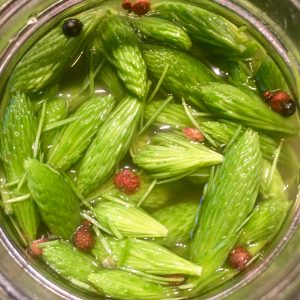
Fermentation is an art as old as recorded history. It seems to have found its way into all cultures in various forms: sauerkraut (Europe), kimchi (Korea), miso (Japan), tempeh (Indonesia), amasi, (Africa), kiviak (Greenland), kvass (Russia), tapache (Mexico). And of course there are always fermented drinks such as beer, wine, kombucha, sake, and mead. Even the Native Americans made a wide variety of alcoholic drinks out of berries, fruits, honey, cacti, and aloe. Some other fermented foods still popular today are sourdough bread, cheese, and yogurt.
Fermentation is a process whereby various microbes (yeast, bacteria, and in some cases mold) are introduced to foods for the sake of preserving it. These microbial organisms feed on sugars, starches, and inulin, which are broken down and produce natural byproducts; these byproducts act to stabilize the food/drink, and protect it from decomposition. In lacto-fermentation, the bacteria, Lactobacillus, converts sugars into lactic acid, which has a mild lemony acidic flavor, common in sauerkraut, lacto-fermented pickles, sourdough, and kombucha to name a few. With enough sugar and yeast, alcohol is produced by fermentation. If alcohol is left out exposed to oxygen, Acetobacter bacteria can feed on the alcohol and convert it into acetic acid, which is the process of developing vinegar.
The term pickling is often thrown around as synonymous to fermentation, but in practice they are different. Whereas lacto-fermentation utilizes microorganisms to culture and preserve food and promotes the development of healthy probiotics, pickling is preserving foods by putting them in vinegar. Vinegar is a wonderful preservative for the simple reason that it is very effective at killing most bacteria, and creating a sterilized environment so that the food is not exposed to the elements which might instigate the process of decomposition.
With lacto-fermented foods, the inclusion of these microorganisms amounts to them being live foods rich in probiotics. This means that not only are they more shelf-stable during the winter, but they are actually great for helping feed the natural bacteria which live in our gut. Healthy gut microflora has been linked to lower levels of inflammation, positive effects on cognition, reduced risk of depression, assistance with our digestion, and overall better function of the immune system.
The methods are a little different depending on what specifically is being fermented and in what way, but typically the basic building blocks are water, food source (sugar), and some sort of culture or in the case of wild fermentation a method for allowing natural microbes to help the process through aerobic fermentation (a process which allows oxygen to assist, usually by means of a loose cloth or coffee filter cover).
There are so many different types of fermentation that it is an exploration which can be as simple or complex as the individual is interested in. In brewing there is a whole art to choosing very specific strains of yeast to cultivate intentionally desired qualities. However wild fermentation is a practice which is much more hands-off and utilizes the yeast/bacteria that is naturally in the environment. This yeast/bacteria can be cultivated quite easily so long as there is water and something to feed them. The white “bloom” (powdery residue) on juniper berries is rich in yeast and has long been used for making sourdough starters. Pine cones, needles, and the skins of fruits are also great for culturing wild yeast, which can be used for making wild beers and sodas.
Cited Sources:
Pubmed: Probiotics, prebiotics, and the host microbiome: the science of translation:
https://www.ncbi.nlm.nih.gov/pubmed/24266656
Gut-Microbiota-Brain Axis and Its Effect on Neuropsychiatric Disorders With Suspected Immune Dysregulation: https://www.ncbi.nlm.nih.gov/pubmed/26046241
Book: Katz, Sandor Ellix. The Art of Fermentation. White river Junction, Vt: Chelsea Green Publishing, 2012
The information contained in this article is not a substitute for the medical care of a licensed healthcare professional, any health concerns should be discussed with your primary care provider.
